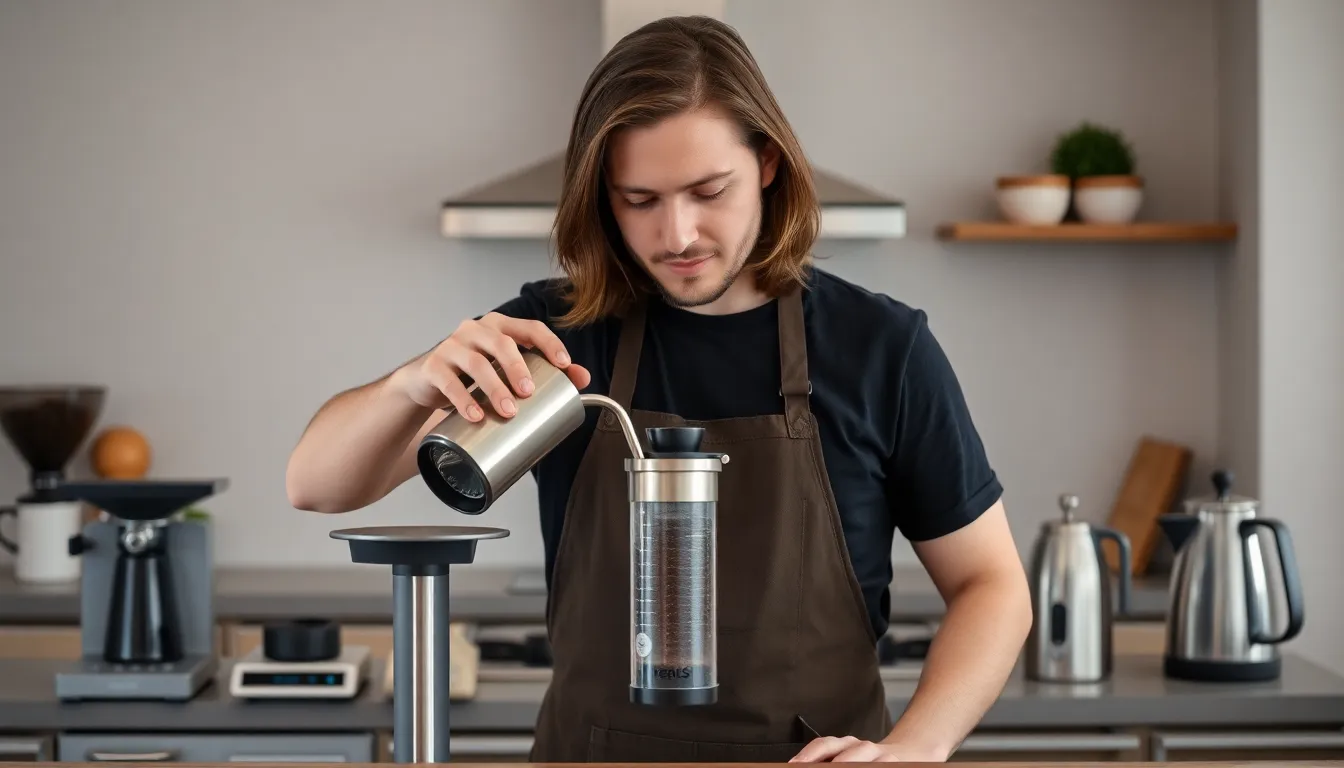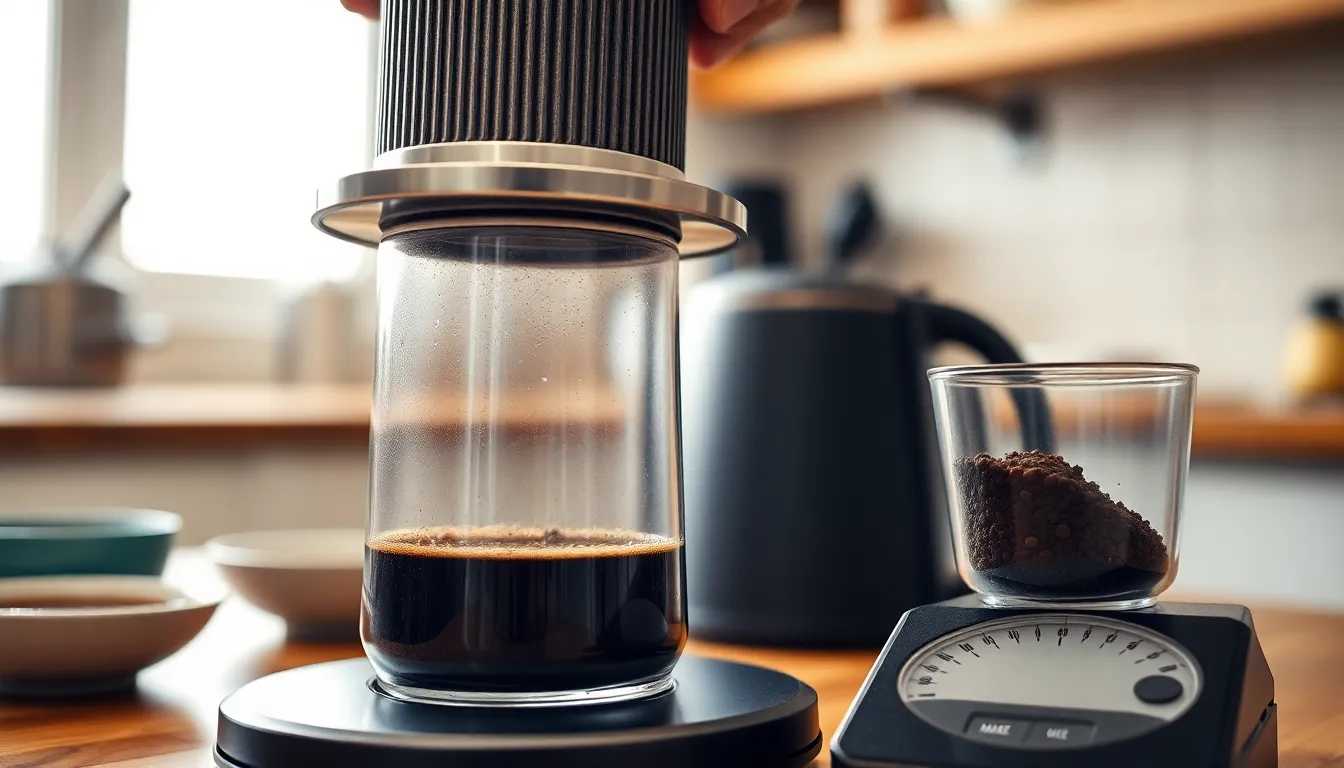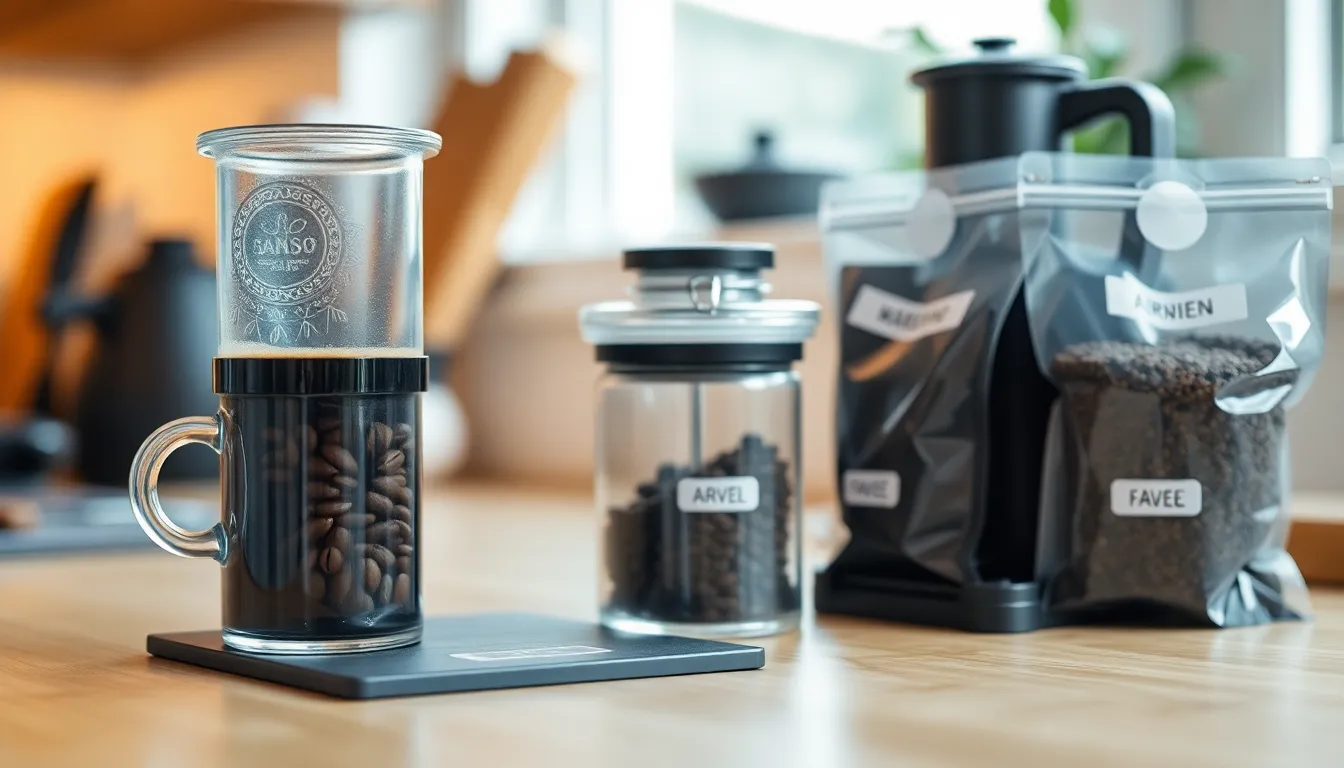We’ve discovered that flipping your AeroPress upside down completely transforms your coffee brewing game. The inverted method gives you total control over steeping time and prevents any unwanted drip-through – something every coffee enthusiast craves for that perfect cup.
This brewing technique has taken the specialty coffee industry by storm because it allows for longer extraction times and more consistent results. Unlike the traditional method where coffee starts dripping immediately we can now steep our grounds for exactly the right duration without losing precious coffee oils and flavors.
The beauty of inverted AeroPress brewing lies in its versatility. Whether you’re after a bold espresso-style concentrate or a smooth filtered coffee we’ll show you how to master this technique with our carefully tested recipes that deliver exceptional results every single time.
What Is the Inverted AeroPress Method
The inverted AeroPress method flips the traditional brewing position by placing the device upside down during the steeping process. We position the plunger at the bottom with the brewing chamber on top, creating a sealed environment that prevents any liquid from dripping through the filter before we’re ready to press.
This technique transforms the AeroPress from a drip-style brewer into an immersion brewing device. We fill the chamber with coffee grounds and hot water, allowing them to steep together without gravity pulling the brew through the filter prematurely. The sealed system gives us complete control over extraction time, letting us experiment with longer steeping periods that would be impossible with the standard method.
Our brewing process begins by inserting the plunger about one inch into the chamber bottom. We then flip the entire assembly so the chamber opening faces upward. Coffee grounds go in first, followed by hot water in a controlled pour. The inverted position lets us stir the mixture thoroughly and time our extraction precisely.
After steeping, we attach the filter cap with a pre-wetted paper filter. The final step involves flipping the entire brewer onto our cup and pressing down steadily. This motion forces the brewed coffee through the filter, creating a clean cup with enhanced flavor clarity.
The inverted method excels at extracting oils and compounds that might otherwise pass through too quickly. We achieve fuller body and more complex flavor profiles because the coffee grounds remain in contact with water for our chosen duration. This control makes the technique particularly valuable for single-origin coffees where we want to showcase unique characteristics.
Professional baristas and home brewers alike favor this approach for its consistency and reproducibility. We can replicate exact brewing parameters from cup to cup, making it easier to dial in recipes and achieve our desired taste profile every time.
Equipment Needed

Before we jump into our inverted AeroPress recipes, we need to gather the right tools for optimal brewing success. Having the proper equipment ensures we can execute this technique safely and achieve consistent results every time.
Essential Tools
AeroPress Device: We use the complete AeroPress brewing system flipped upside down, positioning the plunger at the bottom with the open brewing chamber on top. This inverted positioning creates a sealed environment that prevents premature dripping during steeping.
AeroPress Filters: Paper or metal filters attach to the end of the chamber before we begin the plunging process. These filters determine the final clarity and body of our brew.
Precision Scale: Accurate measurement of both coffee grounds and water is crucial for reproducible results. We recommend a scale that measures to the gram for consistent brewing ratios.
Burr Grinder: Freshly ground coffee beans provide the best flavor extraction. We need a grinder that produces consistent particle size suitable for immersion brewing methods.
Temperature-Controlled Kettle: Hot water at the proper temperature extracts optimal flavors from our coffee grounds. We heat water to exact temperatures based on our chosen recipe parameters.
Digital Timer: Precise timing controls our steeping duration and overall brew time. We track both immersion time and plunging speed for consistent extraction.
Stirring Tool: Gentle stirring breaks up clumps and ensures even saturation of all coffee grounds during the immersion phase.
Serving Mug or Cup: We need a sturdy vessel to catch our brewed coffee after the careful flipping and plunging process.
Optional Accessories
Additional Paper Filters: Using two paper filters creates an even cleaner cup with reduced sediment. We sometimes double-filter for particularly delicate flavor profiles.
Metal Filter Alternative: Reusable metal filters allow more oils and fine particles through, creating different flavor extraction profiles. We switch between paper and metal based on our desired brew characteristics.
Practice Setup: Many brewers benefit from practicing the flipping motion with just water before attempting with coffee. We recommend this safety approach for beginners.
Insulated Brewing Vessels: Temperature-controlled equipment helps maintain consistent brewing conditions throughout the process. We use these tools for more precise temperature management.
Portable Brewing Kits: Carrying cases and travel accessories make inverted brewing possible anywhere. We pack these items for consistent brewing while traveling.
Training Aids: Safe flipping techniques require practice and proper tools to avoid spills or accidents during the inversion process.
Ingredients for Perfect Inverted AeroPress Coffee

Creating exceptional coffee with the inverted AeroPress method begins with selecting quality ingredients that complement this brewing technique. The right combination of coffee beans and water forms the foundation for extracting rich flavors and achieving consistent results.
Coffee Beans Selection
Freshly ground coffee beans deliver the best flavor when using the inverted AeroPress method. We recommend using coffee weights between 14g and 18g for most recipes depending on your desired strength preference.
Coffee Weight Guidelines:
| Recipe Style | Coffee Weight | Water Weight | Ratio |
|---|---|---|---|
| Standard Brew | 14g | 200g | 1:14.3 |
| Espresso Style | 18g | 65g | 1:3.6 |
| Smooth Filter | 18g | 210g | 1:11.7 |
Medium to fine grind sizes work best for inverted brewing because they allow optimal extraction during the steeping process. Adjust your grind based on taste preferences with finer grinds producing stronger coffee and coarser grinds creating smoother profiles. Single origin coffees particularly shine with this method since the immersion brewing extracts complex flavor compounds effectively.
Choose beans roasted within two weeks of brewing for peak freshness and flavor development. Light to medium roasts often perform exceptionally well in inverted AeroPress brewing because the extended steeping time brings out subtle flavor notes without over-extraction.
Water Quality and Temperature
Filtered water at the proper temperature ensures clean extraction and prevents unwanted flavors from interfering with your coffee. We use water heated to approximately 205°F which is just off the boiling point for optimal brewing results.
Water quality significantly impacts the final cup because coffee is roughly 98% water. Use filtered or spring water with balanced mineral content to avoid chlorine taste or excessive hardness that can muddy flavors. The typical coffee to water ratio ranges from 1:11 to 1:12 for most inverted AeroPress recipes.
Temperature consistency matters because water that is too hot can over-extract bitter compounds while cooler water may under-extract resulting in weak or sour notes. Allow boiled water to rest for 30 seconds before pouring to achieve the ideal brewing temperature range.
Basic Inverted AeroPress Recipe

We’ll guide you through our foundational inverted AeroPress recipe that delivers consistent results every time. This method produces a rich cup with excellent flavor extraction using precise measurements and timing.
Prep Instructions
Gather Essential Equipment: We recommend having your AeroPress, paper filter, burr grinder, precision scale, and temperature-controlled kettle ready before starting.
Grind Your Coffee: Measure 14-18 grams of fresh coffee beans and grind them to a medium-fine consistency. The exact amount depends on your desired strength preference and the exact coffee you’re using.
Prepare the Filter: Place the paper filter in the cap and rinse it thoroughly with hot water. This step removes any papery taste and preheats the brewing chamber. Set the rinsed cap aside for later use.
Heat Water: Bring filtered water to approximately 205°F (96°C) for optimal extraction temperature.
Brewing Steps
Position Your AeroPress: Insert the plunger into the chamber about one inch from the bottom and flip the entire device upside down. This creates our inverted brewing position that prevents premature dripping.
Add Ground Coffee: Pour your measured coffee grounds into the inverted chamber. Give it a gentle shake to level the coffee bed for even extraction.
Pour Water: Add 100-200 grams of hot water depending on your recipe preference. For a 1:11 ratio, we use 150-200 grams of water with 14-18 grams of coffee.
Stir and Steep: Mix the coffee and water thoroughly with a stirring tool for 10-15 seconds. Allow the mixture to steep for 1-2 minutes for proper extraction.
Attach the Cap: Secure the pre-wetted filter cap to the top of the chamber, ensuring it’s tightly fastened.
Flip and Press Technique
Execute the Flip: Position your cup on top of the filter cap and quickly but carefully invert the entire AeroPress in one smooth motion. Confidence is key during this step to prevent spills.
Apply Steady Pressure: Press the plunger down slowly and steadily over 30 seconds. We aim for consistent pressure throughout the pressing motion.
Listen for the Hiss: Stop pressing when you hear the characteristic hissing sound, which indicates most of the liquid has been extracted.
Final Adjustments: If the resulting coffee tastes too strong, dilute it with 20-40 grams of hot water. For weak coffee, try grinding finer or increasing the coffee dose in your next brew.
Advanced Inverted AeroPress Recipes

We’ll explore three distinct inverted AeroPress recipes that showcase the versatility of this brewing method. Each recipe targets different flavor profiles and brewing preferences to expand your coffee repertoire.
Strong and Bold Brew
We start by inserting the plunger into the chamber with the rubber seal positioned just inside the opening. Our inverted setup places the chamber upright with the plunger serving as the base.
Coffee and Water Specifications:
- Coffee dose: 18-22g finely to medium ground coffee
- Water amount: 200-220g
- Water temperature: 90-96°C (194-205°F)
We add our coffee grounds to the inverted chamber and start the timer immediately. Pour water to fill the chamber completely. At the 15-20 second mark we stir the mixture thoroughly to ensure even saturation. We attach the pre-wetted filter at 40 seconds and carefully invert the entire unit onto our cup. The plunging process should take 20-30 seconds with steady pressure. Our total brew time ranges from 1 minute 10 seconds to 1 minute 30 seconds.
This method produces a concentrated full-bodied cup with intense flavor characteristics and rich mouthfeel.
Light and Smooth Coffee
Our setup remains identical to the strong brew method with the inverted AeroPress configuration. This recipe emphasizes clarity and brightness over intensity.
Coffee and Water Specifications:
- Coffee dose: 15g medium ground coffee
- Water amount: 240g total
- Water temperature: 84-88°C (183-190°F)
We begin by adding coffee grounds and pouring 150g of water into the chamber. Stir the mixture for 20 seconds to achieve proper extraction. After attaching the filter we wait for 1 minute total steeping time. The inversion and pressing should be gentle and controlled over 20 seconds. We add the remaining water directly to the finished coffee to reach our desired strength.
This approach delivers a clean smooth cup with lightly acidic notes and delicate flavor nuances.
Cold Brew Variation
We use the same inverted setup but adapt our parameters for cold extraction methods. This technique transforms the AeroPress into a cold brewing vessel.
Coffee and Water Specifications:
- Coffee dose: 18g coarse ground coffee
- Water amount: 200g cold or room temperature water
- Steeping time: 12-18 hours
We add coarsely ground coffee to the inverted chamber and pour cold water slowly to ensure complete saturation. Gentle stirring prevents over-agitation while promoting even extraction. After attaching the filter we allow the mixture to steep for 12-18 hours at room temperature or in the refrigerator. The final step involves careful inversion and slow pressing to extract our concentrate.
This method produces a smooth low-acid cold brew concentrate with minimal bitterness and enhanced sweetness.
Grind Size and Coffee-to-Water Ratios

Getting the grind size and coffee-to-water ratio right forms the foundation of exceptional inverted AeroPress brewing. We’ll explore how these two critical variables work together to unlock the full potential of your coffee.
Finding Your Perfect Grind
We recommend starting with a fine to medium-fine grind for most inverted AeroPress recipes. Calvin’s recipe specifies a grind “just finer than you would for a small V60,” which aligns perfectly with the majority of successful AeroPress brewing approaches. Counter Culture Coffee takes a slightly different approach, suggesting a medium-fine grind that registers around four on a 1-10 scale.
Fine grinds increase extraction efficiency but carry the risk of over-extraction or filter clogging during the pressing phase. Medium-fine grinds strike an optimal balance between flavor extraction and smooth flow rate. We suggest adjusting your grind size based on several key factors: your taste preferences, desired brew time, and the roast level of your beans.
Testing different grind sizes allows you to dial in the perfect extraction for your exact setup and preferences. Start with medium-fine and adjust finer if you want more intensity or coarser if the brew tastes over-extracted or bitter.
Adjusting Ratios for Taste
Coffee-to-water ratios between 1:12 and 1:13 deliver the sweet spot for strength and clarity in inverted brewing. Counter Culture Coffee uses 18 grams of coffee with 210 grams of water, creating approximately a 1:12 ratio that produces a robust and flavorful cup. Calvin’s recipe employs 15 grams of coffee with 200 grams of water, resulting in a slightly higher 1:13 ratio for a more balanced profile.
Increasing your coffee-to-water ratio by using more coffee or less water intensifies both flavor and body characteristics. Decreasing the ratio with less coffee or more water creates a lighter, more delicate cup that highlights subtle flavor notes.
| Recipe Source | Coffee (g) | Water (g) | Ratio | Grind | Brew Time |
|---|---|---|---|---|---|
| Calvin’s Simple | 15 | 200 | 1:13.3 | Fine | 1:45 |
| Counter Culture | 18 | 210 | 1:12 | Medium-fine | 2:00 |
We can push ratios to 1:14 for softer, more approachable profiles or strengthen them to 1:10 for concentrated brews, though these extremes appear less frequently in proven inverted recipes. Both featured recipes pour all water at once and recommend steeping for 1-2 minutes before pressing, giving you a reliable framework for experimentation.
Steeping Times and Techniques

We can achieve dramatically different flavor profiles by adjusting our steeping time in the inverted AeroPress method. These timing variations allow us to control extraction intensity and develop our preferred taste characteristics.
Short Steep Method
We typically add hot water to our coffee grounds in the inverted AeroPress chamber and stir briefly for optimal contact. Our steeping time ranges from 1 to 2 minutes before we carefully flip the device over onto our cup for pressing.
This shorter immersion time produces a brighter and cleaner cup with less intensity in body and extraction. We achieve excellent results when we want to highlight the acidic notes and delicate flavors in our coffee beans.
The technique works particularly well with light roasts where we want to preserve the subtle flavor nuances without overwhelming bitterness. We recommend stirring our grounds immediately after adding water to ensure even saturation throughout the brief steeping period.
Extended Steeping
We extend our immersion time to around 3 minutes or longer before pressing when we desire a fuller extraction. This longer contact between water and grounds intensifies our extraction process and results in a fuller-bodied and more robust cup.
Extended steeping allows more flavor compounds to dissolve into our brew but we must take care to avoid over-extraction or unwanted bitterness. We find this method popular in competition settings and among enthusiasts who seek deeper and more balanced flavor profiles.
Professional baristas and Industry AeroPress Championship winners have embraced this technique for its flavor benefits and control over steeping time. We can experiment with steeping times beyond 3 minutes but should monitor our extraction carefully to prevent bitter notes from dominating our cup.
During extended steeping we often stir our grounds multiple times to ensure consistent extraction throughout the longer immersion period. We recommend using slightly coarser grinds when extending our steeping time to prevent over-extraction while still achieving the desired flavor intensity.
Troubleshooting Common Issues

Even experienced coffee enthusiasts encounter challenges when perfecting their inverted AeroPress technique. We’ve identified the most common brewing problems and their practical answers to ensure consistent results.
Avoiding Spills During Flip
The flipping motion represents the most critical step in inverted brewing. We recommend ensuring the plunger is positioned all the way out to create a proper seal before attempting the flip. Position your receiving cup firmly on top of the filter cap and maintain steady pressure while executing the rotation.
Practice the flipping motion with just water before brewing your first batch. Flip slowly and confidently to maintain complete control throughout the process. The key lies in creating one smooth continuous motion rather than hesitating midway through the flip.
Keep your workspace clear and have a towel nearby for any minor spills during the learning process. We find that most accidents occur when brewers rush the flip or fail to secure the plunger properly.
Fixing Over-Extraction
Over-extracted coffee tastes bitter and harsh due to excessive extraction of undesirable compounds. We address this issue by adjusting the grind size to a coarser setting to reduce the surface area exposed to water. Reducing the steeping time below 2 minutes also prevents excessive extraction.
Lower water temperature by 10-15 degrees helps minimize over-extraction while maintaining proper extraction of desirable flavors. We recommend experimenting with a 1:13 or 1:14 coffee-to-water ratio to dilute the concentration and balance the flavors.
Monitor your grind consistency since uneven particles can lead to simultaneous over and under-extraction. Burr grinders produce more uniform particles compared to blade grinders for better extraction control.
Dealing with Under-Extraction
Under-extracted coffee appears weak and sour due to insufficient extraction of flavor compounds. We solve this by grinding coffee finer to increase surface area and improve extraction efficiency. Extending the steeping time beyond 2 minutes allows more complete extraction of desirable compounds.
Increase water temperature to 205-208°F to enhance extraction without scorching the coffee. We also recommend using a higher coffee-to-water ratio like 1:11 to concentrate the flavors and improve body.
Ensure complete saturation by stirring the coffee grounds thoroughly after adding water. Uneven wetting creates pockets of dry coffee that remain under-extracted even though proper timing and temperature.
Pro Tips for Inverted AeroPress Success

Mastering the inverted AeroPress technique requires attention to detail and safety awareness. We recommend starting with these essential tips to elevate your brewing game and avoid common mistakes.
Safety remains our top priority when working with the inverted method. Pressure builds up inside the chamber during brewing, making the flipping motion potentially hazardous if not executed properly. We always caution brewers to handle the device with confidence and deliberate movements to prevent accidents.
Practice makes perfect when learning the inversion technique. Using tap water to rehearse the flip before handling hot liquids builds muscle memory and prevents costly spills. We suggest dedicating time to this practice until the motion becomes second nature.
Consistency proves key to achieving repeatable results with every cup. Keeping track of your brewing variables including grind size, water temperature, steeping time, and coffee measurements ensures you can replicate successful brews. We maintain brewing logs to identify patterns and refine our techniques over time.
Filter experimentation opens new flavor possibilities in your brewing journey. Using two paper filters instead of one can alter the flavor profile by increasing filtration and reducing oils in the final cup. We find this technique particularly effective when seeking cleaner, brighter flavor characteristics.
| Variable | Recommended Range | Impact on Flavor |
|---|---|---|
| Water Temperature | 84°C – 96°C | Higher temps extract more compounds |
| Steeping Time | 1-4 minutes | Longer steeps increase body and strength |
| Coffee Amount | 14-35g | More coffee creates stronger concentration |
| Grind Size | Medium-coarse | Finer grinds extract faster |
Temperature control significantly affects extraction quality in inverted brewing. We monitor water temperature closely, aiming for 84°C as recommended in advanced recipes for optimal flavor balance without over-extraction.
Timing precision transforms good coffee into exceptional coffee. We use digital timers to track every phase of the brewing process, from initial pour to final plunge, ensuring reproducible results across multiple brewing sessions.
Equipment preparation streamlines the entire brewing process. Pre-wetting filters, warming the brewing vessel, and having all tools within reach prevents rushing during critical brewing moments and maintains proper temperatures throughout extraction.
Storage and Make-Ahead Options

We can streamline our inverted AeroPress brewing routine by implementing smart storage and preparation strategies that save time while maintaining coffee quality. Proper storage techniques ensure we always have fresh ingredients ready for our brewing sessions.
Coffee Bean Storage
Freshly ground coffee beans can be stored for up to one week when properly sealed in an airtight container. We recommend grinding coffee beans just before brewing for optimal flavor extraction. Whole coffee beans maintain their freshness longer than pre-ground coffee when stored in a cool, dark place away from direct sunlight.
Prepared Coffee Storage
Brewed inverted AeroPress coffee can be refrigerated for up to 24 hours after preparation. We store our finished coffee in glass containers with tight-fitting lids to preserve flavor integrity. Cold storage works particularly well for concentrate-style brews that we plan to dilute later with hot water or milk.
Pre-Brewing Preparation
We can measure and portion our coffee grounds the night before brewing to streamline our morning routine. Sealed containers or small bags keep pre-measured portions fresh overnight. Water can be heated and stored in thermal carafes for immediate use when we wake up.
Equipment Organization
Organizing our AeroPress equipment in a dedicated storage area reduces preparation time significantly. We keep our device, filters, and accessories in a compact brewing station for easy access. Clean, dry storage prevents contamination and ensures our equipment remains ready for immediate use.
Batch Brewing Considerations
| Storage Method | Duration | Best Use |
|---|---|---|
| Refrigerated brewed coffee | 24 hours | Daily consumption |
| Pre-ground coffee (sealed) | 7 days | Weekly preparation |
| Whole beans (proper storage) | 2-4 weeks | Extended freshness |
Multiple cups can be brewed in succession using the inverted method when entertaining guests or preparing coffee for the workweek. We find that brewing three to four cups consecutively works well before equipment requires cleaning.
Conclusion
The inverted AeroPress method opens up a industry of brewing possibilities that we’ve only begun to explore. With the right equipment preparation and ingredient selection you’re now equipped to create everything from bold concentrates to delicate light roasts.
Remember that mastering this technique takes practice but the results speak for themselves. We encourage you to experiment with different grind sizes steeping times and ratios to discover your perfect cup. The beauty of inverted brewing lies in its consistency and reproducibility.
Whether you’re brewing for yourself or entertaining guests these techniques and storage strategies will help you maintain quality while streamlining your routine. Your coffee journey with the inverted AeroPress method has just begun.
Frequently Asked Questions
What is the inverted AeroPress method?
The inverted AeroPress method involves flipping the device upside down during brewing, creating a sealed environment that prevents premature dripping. This transforms the AeroPress into an immersion brewing device, allowing coffee grounds and hot water to steep together without gravity interference for enhanced flavor extraction.
Why should I use the inverted method instead of the standard AeroPress technique?
The inverted method offers better control over steeping time and prevents unwanted drip-through, leading to more flavorful coffee. It allows for longer extraction times, produces fuller body and complex flavor profiles, and provides more consistent, reproducible results compared to the standard method.
What equipment do I need for inverted AeroPress brewing?
Essential equipment includes the AeroPress device, paper filters, a precision scale, burr grinder, temperature-controlled kettle, digital timer, and stirring tool. Optional accessories include metal filters, insulated brewing vessels, and additional paper filters for enhanced brewing experiences.
What coffee-to-water ratio should I use for inverted AeroPress?
The ideal coffee-to-water ratio ranges from 1:11 to 1:13, depending on your taste preferences. For example, use 15-18g of coffee with 200-240g of water. Start with 1:12 as a baseline and adjust based on whether you prefer stronger or lighter coffee.
What grind size works best for the inverted AeroPress method?
Medium to fine grind sizes work best for optimal extraction. Start with a fine to medium-fine grind and adjust based on taste. Finer grinds extract more quickly and produce stronger flavors, while coarser grinds result in lighter, cleaner cups.
How long should I steep coffee using the inverted method?
Steeping times typically range from 1-4 minutes. Short steeps (1-2 minutes) produce brighter, cleaner cups ideal for light roasts, while extended steeps (3+ minutes) create fuller-bodied brews. Experiment with different times to find your preferred flavor profile.
What water temperature is best for inverted AeroPress brewing?
The optimal water temperature is approximately 205°F (96°C). This temperature ensures proper extraction without over-extracting bitter compounds. If you don’t have a thermometer, let boiling water rest for 30-45 seconds before brewing.
How do I avoid spills when flipping the AeroPress?
Practice the flipping motion with just water before brewing coffee. Work over a sink initially, use steady movements, and ensure the filter is properly sealed. Keep your movements confident and quick to minimize spill risk during the flip.
Can I make cold brew with the inverted AeroPress method?
Yes! Use 18g of coarse ground coffee with 200g of cold water. Steep for 12-24 hours at room temperature or in the refrigerator, then flip and press as usual. This creates a smooth, low-acid cold brew concentrate.
How should I store my coffee beans and brewed coffee?
Store whole beans in an airtight container in a cool, dark place for 2-4 weeks. Freshly ground coffee should be used within one week when stored properly. Brewed coffee can be refrigerated in glass containers for up to 24 hours while maintaining flavor quality.







